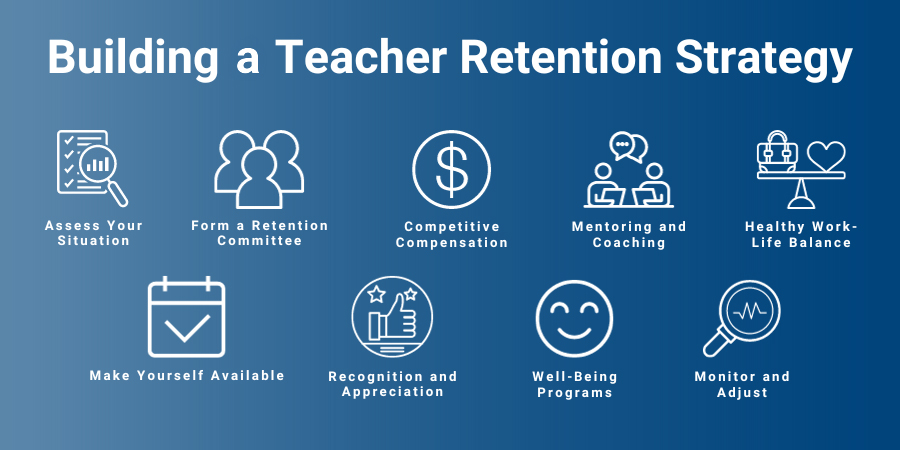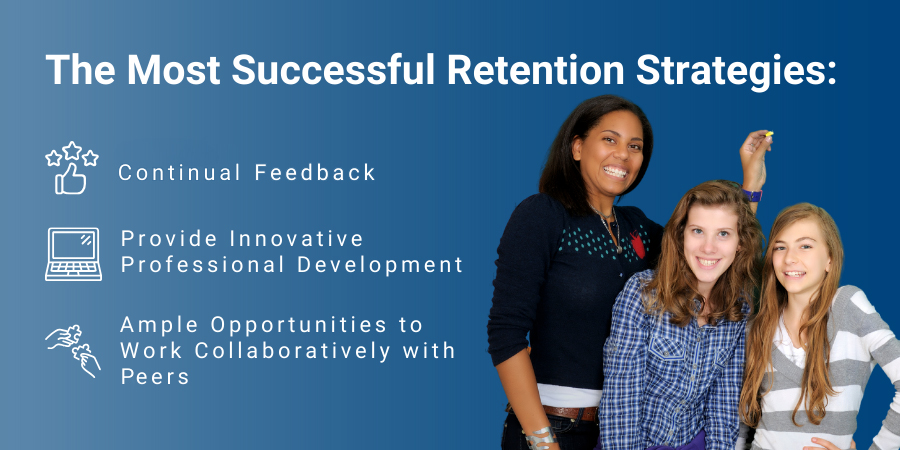Teacher recruitment and retention are major, top-of-mind issues for school administrators nationwide, as teacher shortages due to stress and burnout continue year after year. Because educator turnover can have a negative impact on student learning and school culture, the value that highly experienced, dedicated teachers bring to schools and students cannot be overstated. A robust veteran teacher workforce not only helps enhance student outcomes but also provides continuity and stability to a school community’s culture. Administrators play a crucial role in creating an environment where teachers feel valued, supported, and motivated to stay in their positions.
Building Your Teacher Retention Strategy Plan
Designing a comprehensive teacher retention plan is an essential part of creating a positive school culture and supportive environment—the kind that makes teachers want to be a long-term part of the community and inspires them to excel in their roles.
Here’s a step-by-step plan school principals and district administrators can implement to improve teacher retention:
- Assess Your Current Situation
Recruitment and hiring are a part of most school administrators’ summer duties. However, doing so to replace lost teachers is a different problem than an increased demand for more teachers. Gather all relevant data on your school’s teacher turnover and attrition rates during the past few years. Conduct research through surveys or exit interviews to understand the reasons teachers leave the school to identify any patterns or common issues contributing to the turnover. - Form a Retention Committee
Establish a committee of administrators, a select mix of long-tenured and new, promising teachers, as well as involved parents or other community stakeholders to help develop and implement new teacher retention strategies. Ensure diversity and representation within the committee to consider different perspectives. - Ensure Competitive Compensation
Review your teachers’ salary structure and benefits packages to ensure they are on par and competitive with surrounding school districts in the region. Learning Policy Institute research calls teacher salaries a key factor in recruitment and retention, with one RAND Corporation report revealing insufficient pay was the top reason teachers younger than 40 left their positions during the COVID-19 pandemic. According to research by The Journalist’s Resource at Harvard Kennedy School’s Shorenstein Center, increased pay is associated with improved teacher retention and a higher likelihood of hiring teachers who earned top scores on their educator certification exams, among other benefits. Budgets are always tight, but administrators should still advocate for allocation to raise teachers’ salaries and improve benefits when possible. - Implement Mentoring and Coaching
Help teachers build meaningful peer relationships and boost their skills at the same time by implementing a mentorship program in which experienced veteran teachers are partnered with newer teachers. Provide regular coaching sessions to help teachers improve their teaching techniques and classroom management skills. - Encourage a Healthy Work-Life Balance
Set a good example and promote a healthy work-life balance by setting clear expectations for teachers’ working hours. Avoid excessive workloads, and consider flexible scheduling options to give teachers the gift of additional planning and preparation time during the course of the workday. - Make Yourself Available
As a supportive school leader, develop strong communication channels between teachers and building or district administration. Conduct regular check-ins or mini town halls with teachers to solicit questions, address concerns, provide feedback, and offer support. - Practice Recognition and Appreciation
Show them you value their efforts by implementing a system to recognize and celebrate teachers’ achievements, accomplishments, and contributions with the wider school community. Organize catered meals or other simple, fun events or awards highlighting outstanding teaching and dedication. - Establish Well-Being Programs
Introduce wellness programs and self-help resources focusing on teachers’ physical, mental, and emotional health. Set up a teachers-only helpline with a licensed counselor and provide easy access to therapy services or other workshops for managing stress and maintaining positive well-being. - Continuously Monitor and Adjust
Regularly assess the effectiveness of the retention plan’s strategies and efforts by reviewing staff turnover rates, teacher satisfaction surveys, and feedback from the retention committee. Use this feedback and insights to continually improve the retention plan’s strategies or address any recurring concerns, ensuring its ongoing relevance and impact on the school’s retention and attrition rates.

The Positive Impact of Teacher Retention
High teacher retention rates offer several significant benefits to both schools and their students, but not all teacher turnover is always a net negative. Some turnover can bring fresh perspectives and new ideas into a school, and not every teacher will be the perfect fit in every school community. Striking a balance between retaining experienced teachers and welcoming new talent can be key to a school’s growth and success. Keeping that new talent retained can be a positive contribution in three key areas:
- Schools Save Time and Money — Teacher turnover is costly to schools’ budgets and resources. Learning Policy Institute research analysis says expenses related to separation, recruitment, hiring, and training can range from $9,000 to $20,000 or more per teacher. The human resources responsibilities alone—screening and interviewing candidates, onboarding new hires, and providing training—are extensive and time-consuming. Schools with high retention rates can save significantly on annual investments of valuable time and financial resources in recruiting, hiring, and training new teachers.
- Creating a Consistent, Stable School Community Culture — Continuity in the classrooms creates a more stable learning environment for students, helping them benefit academically and emotionally from building strong, trusting relationships with teachers over time. High teacher retention contributes to the overall development of a cohesive, positive, and supportive school culture. Teachers who stay within the same school district for extended periods become much more integrated into the school community, fostering a stronger sense of belonging and unity.
- Enhanced Teaching Quality and Student Achievement — Learning Policy Institute’s research shows high teacher turnover rates have a negative impact on student achievement. A study by University of Michigan researchers correlates high teacher turnover to low student test scores. An increase in teacher turnover by just 1 percent resulted in lower math scores by 2 percent, with test scores across all subjects averaging 6–10 percent lower in schools with high turnover rates. Experienced teachers tend to be more effective in the classroom, drawing on accumulated knowledge and expertise gained through high-quality training and experience.

Why Are Teachers Leaving the Classroom?
Teacher attrition and turnover were already a concern for many school districts before COVID-19, but the global pandemic only exacerbated the issue. According to Brookings Institute research, 42 percent of surveyed teachers said they’d considered retiring or leaving the profession—with just more than half citing COVID-19 and related challenges as their primary reason.
Other common reasons causing teachers to leave their classrooms and the profession include:
- A Lack of Leadership Support — In one National Center for Education Statistics (NCES) survey, teachers who strongly disagreed that their administration was supportive were more than twice as likely to leave their school than teachers who reported feeling supported.
- Feeling Undervalued — Only 36 percent of US teachers believe American society values their profession, according to another NCES survey. Low salaries not commensurate with their education and the demands of the job make it financially challenging for many teachers to stay in education for long-term careers.
- Dissatisfaction with Working Conditions, Standardized Testing Pressures, and Stressful Workloads — Teaching can be mentally and emotionally demanding, with teachers often working long hours, juggling extra responsibilities, and facing accountability to “teach to the tests” or pressure to reach student achievement benchmarks.
Cultivating Collaboration to Support and Retain Teachers
Encouraging teachers to build collaborative relationships with their colleagues has proven to increase retention rates. Giving teachers the time and opportunities to connect, collaborate, and exchange ideas helps cultivate a supportive, positive work environment that focuses on constant incremental improvement.
In a Charlotte Advocates for Education study examining how principals’ leadership can increase teacher retention, principals successfully retaining teachers displayed similar characteristics to successful entrepreneurs. Both are self-motivated problem-solvers, cautious risk-takers, and passionate, visionary leaders who understand the value of their people.
The most successful strategies for principals succeeding at retaining teachers include those that directly assist educators. Proactive principals provide continual feedback and find ways to provide innovative professional development, and they ensure that teachers have ample opportunities to work collaboratively with their peers and increase their leadership abilities.

Building Up New Teachers from the Beginning
An NCES and US Department of Education study shows that, without a mentor, nearly one in three new teachers leave the classroom by their fifth year in the profession. However, with a supportive and experienced mentor, that ratio drops by more than half to just one in seven.
There are many more examples and substantial evidence supporting the idea that mentorship and induction programs are highly beneficial to new teachers and can influence the retention and success rates of new educators while providing:
- Improved Teacher Satisfaction: When new teachers have the support and guidance they need to navigate the challenges of their first years in the classroom—and they feel supported, valued, and cared for—they’re much more likely to be satisfied with their career and have a desire to stay and grow in their role.
- Increased Effectiveness and Student Achievement: Personalized mentorship and training focused on improving teaching practices and classroom management techniques can have a dramatic effect. Those who receive guidance from a peer mentor tend to be more effective teachers, and their students typically perform better academically—giving another big boost to their self-confidence and job satisfaction.
- Cultural Integration: New, younger teachers often need assistance acclimating to the workplace dynamics, culture, and expectations of their new school and community. Mentorship and onboarding induction programs can help new educators plant professional roots and build positive relationships with their colleagues, administrators, students, parents, and the entire school community.

Empowerment and Autonomy Impacting Teacher Retention
A 2020 study by England’s National Foundation of Education Research (NFER) suggests empowering teachers with autonomy is strongly associated with improved job satisfaction and a greater intention to remain in the teaching profession. However, teachers are 16 percent less likely than other professionals to report having a lot of influence over how they do their job, and nearly 40 percent of teachers say they have no or little influence over their personal professional development goals.
“Autonomy plays a significant role in teachers’ motivation. Giving teachers greater influence over how they do their job has the potential to increase job satisfaction, which in turn is important in tackling teacher retention. At a time when the school system cannot afford to lose valuable teachers, improving autonomy, workload, satisfaction, and retention could help address the teacher supply challenge,” says Jack Worth, lead economist for the NFER.
The NFER’s research shows that teachers feeling they have an influence over their professional development goal-setting is the area most associated with higher job satisfaction and a greater intention to stay in the profession.


